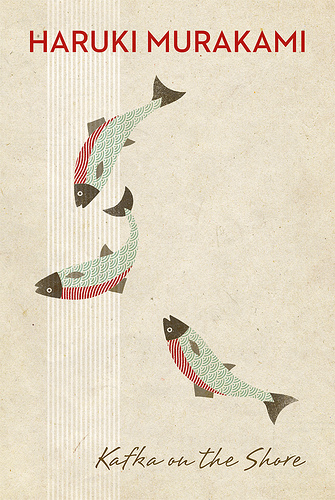Prologue
Well it’s easy to immerse yourself in Haruki Murakami’s world: a fantastic journey into a subconsciously unknown destination, a labyrinth, and a library. Yes, somewhere in between cats do converse with humans and a magical forest surfaces when something like an interstellar gate of consciousness, the so-called ‘entrance stone’ is opened up. Difficult to fathom? There is more to the puzzle, is there a UFO X-files incident? And does the avatar of the 15 year-old boy named Kafka, Mr. Nakata, kill the father?
Well, one thing is certain, I have finished reading Kafka on the shore two weeks ago but I still think about the intensity of its metaphysical structure and the metaphor it delivered so consistently throughout the book; that it does so prominently and for the reader that expects to find an answer, probably this will not be the case.

Illustration by Zara Picken.
Plot & writing
Strange and unexplained phenomena occur which take the plot and characters into a parallel journey of self-discovery. Comprising two distinct but interrelated plots — Kafka and Mr. Nakata — the narrative runs back and forth between the two, taking up each plotline in alternating chapters. The story is set out in Japan.
The writing style of Murakami is simple and austere, which makes the story that is filled with elements of magic realism easy to follow regardless of the many loose ends that the author has decided to leave unclear.
In context Murakami masterfully morphs Greek mythology and cultivates it into contemporary writing. The idea of the labyrinth as a metaphor is explored throughout the book, as well as the Oedipus syndrome.
Particular passages in the book operate self-reflectively to the reader and that is what makes his writing so intellectually pleasant. Here is a passage I was particularly fond of:
Sometimes fate is like a small sandstorm that keeps changing directions. You change direction but the sandstorm chases you. You turn again, but the storm adjusts. Over and over you play this out, like some ominous dance with death just before dawn. Why? Because this storm isn’t something that blew in from far away, something that has nothing to do with you. This storm is you. Something inside of you. So all you can do is give in to it, step right inside the storm, closing your eyes and plugging up your ears so the sand doesn’t get in, and walk through it, step by step. There’s no sun there, no moon, no direction, no sense of time. Just fine white sand swirling up into the sky like pulverized bones. That’s the kind of sandstorm you need to imagine.
An you really will have to make it through that violent, metaphysical, symbolic storm. No matter how metaphysical or symbolic it might be, make no mistake about it: it will cut through flesh like a thousand razor blades. People will bleed there, and you will bleed too. Hot, red blood. You’ll catch that blood in your hands, your own blood and the blood of others.
And once the storm is over you won’t remember how you made it through, how you managed to survive. You won’t even be sure, in fact, whether the storm is really over. But one thing is certain. When you come out of the storm you won’t be the same person who walked in. That’s what this storm’s all about.

Audrey says,
“That’s what this storm’s all about”
That’s what that storm was all about.
on 09 May 2011 / 8:43 PM